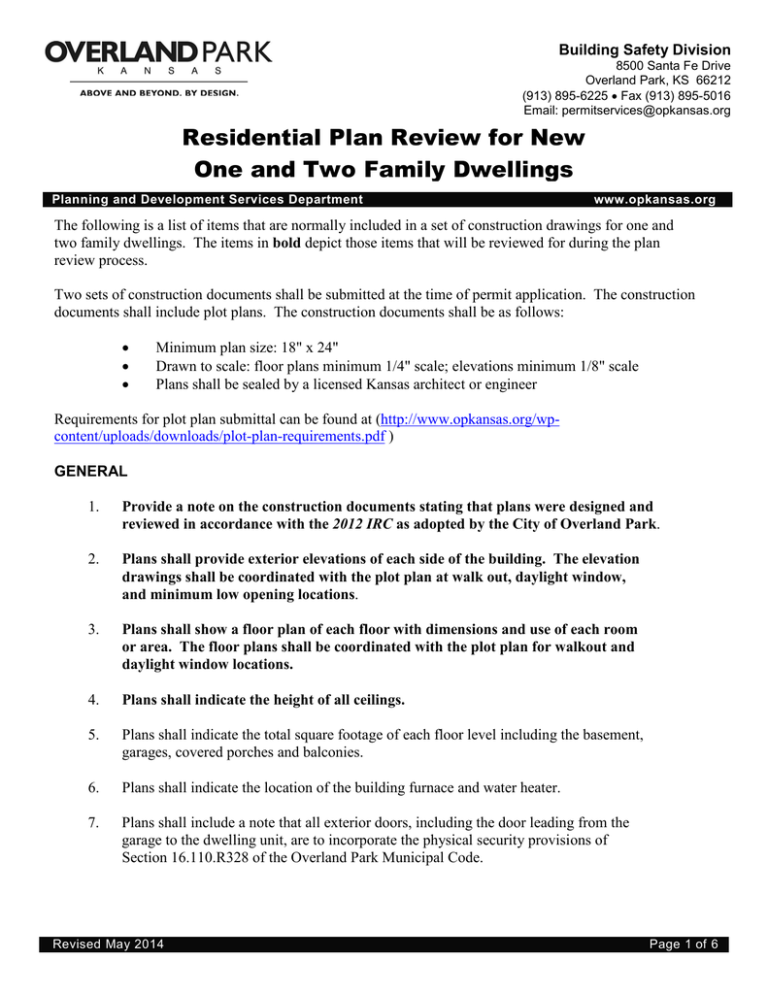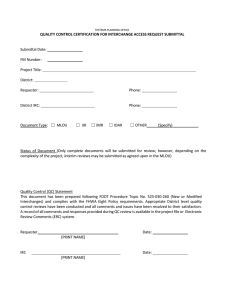title heading - City of Overland Park, Kansas
advertisement

Building Safety Division 8500 Santa Fe Drive Overland Park, KS 66212 (913) 895-6225 • Fax (913) 895-5016 Email: permitservices@opkansas.org Residential Plan Review for New One and Two Family Dwellings Planning and Development Services Department www.opkansas.org The following is a list of items that are normally included in a set of construction drawings for one and two family dwellings. The items in bold depict those items that will be reviewed for during the plan review process. Two sets of construction documents shall be submitted at the time of permit application. The construction documents shall include plot plans. The construction documents shall be as follows: • • • Minimum plan size: 18" x 24" Drawn to scale: floor plans minimum 1/4" scale; elevations minimum 1/8" scale Plans shall be sealed by a licensed Kansas architect or engineer Requirements for plot plan submittal can be found at (http://www.opkansas.org/wpcontent/uploads/downloads/plot-plan-requirements.pdf ) GENERAL 1. Provide a note on the construction documents stating that plans were designed and reviewed in accordance with the 2012 IRC as adopted by the City of Overland Park. 2. Plans shall provide exterior elevations of each side of the building. The elevation drawings shall be coordinated with the plot plan at walk out, daylight window, and minimum low opening locations. 3. Plans shall show a floor plan of each floor with dimensions and use of each room or area. The floor plans shall be coordinated with the plot plan for walkout and daylight window locations. 4. Plans shall indicate the height of all ceilings. 5. Plans shall indicate the total square footage of each floor level including the basement, garages, covered porches and balconies. 6. Plans shall indicate the location of the building furnace and water heater. 7. Plans shall include a note that all exterior doors, including the door leading from the garage to the dwelling unit, are to incorporate the physical security provisions of Section 16.110.R328 of the Overland Park Municipal Code. Revised May 2014 Page 1 of 6 8. Plans shall indicate that the dwelling will comply with the following load conditions: Area Balconies (exterior) and Decks Ceiling joists - attics w/o storage (scuttle access only) Ceiling joists - attics w/ storage (door or pull down ladder access) Rooms-non-sleeping Sleeping rooms Roof-light roof covering Roof-heavy roof covering (concrete / tile / slate) Minimum Dead Load 10 Minimum Live Load 40 10 10 10 20 10 10 10 40 30 20 20 20 FOUNDATION 9. The plan shall note that the foundation design is in compliance with one of the following standards: • • • • Johnson County Residential Foundation Guideline Chapter 4 of the 2012 IRC ACI 318 ACI 332 Plans submitted in accordance with ACI 318 shall include the structural analysis as well as the construction details. 10. Indicate on the plans that the foundation walls are to be damp-proofed or water proofed (2012 IRC Section R406). When the foundation is specified to be waterproofed, details or notes for waterproofing shall be provided. 11. Plans shall note how the foundation drainage is to be addressed, e.g., Drain tile, gravel or perforated pipe shall be installed at or below the area to be protected and shall discharge by gravity or mechanical means into an approved drainage system. 12. The plan shall indicate that footings shall extend below the frost line – a minimum depth of 36 inches below grade is required in Overland Park, Kansas. 13. The plan shall note the minimum size of footings. The footing details shall show a minimum of two continuous #4 bars (OPMC; Section R401.2.2). 14. The plan shall indicate the location, size and construction details for column pads and interior footings. Loads imposed on column pads shall be shown on the plans in Kips. Loads imposed on interior footings shall be shown on the plans in pounds per lineal foot. Revised May 2014 Page 2 of 6 15. The plan shall note and detail the location of all foundation wall reinforcement. 16. The plan shall note that interior footings of load bearing walls and columns shall be isolated from the basement floor slab. 17. The plan shall note that anchor bolts shall not be spaced more than 3 feet on center and be embedded into the concrete a minimum of 7”. 18. Braced wall panels having hold down devices that are anchored into the foundation, shall be detailed on the foundation plan. The foundation plan shall identify the type of device and dimension the location of each anchor. 19. Plans having foundations designed in accordance with the Johnson County Foundation Guideline shall indicate the location of all return walls. Additionally, all construction details for such walls shall be provided on the foundation plan. 20. The plan shall provide construction details for all floor slabs which are supported by fill material which exceeds 24 inches of granular fill or 8 inches of earth. Where applicable, garage floor slabs and certain over dig situations may be constructed in accordance with Johnson County Residential Foundation Guidelines (applicable notes and details shall be provided). 21. The plan shall provide construction details for openings in foundation walls. Foundation window wells for emergency means of egress and rescue shall provide a minimum horizontal opening of 3' x 3' (2012 IRC R310.2). STAIRWAYS 22. Indicate on the plan that the maximum riser height of stairways shall not exceed 7-3/4 inches and the treads shall provide a minimum tread depth of 10-inches (IRC 2012 R311.7.5.1). 23. Winding stairs and their associated floor openings shall be fully dimensioned and detailed. A dimensioned drawing shall show the elevation of the stair and the tread dimension at the 12 inch walk line shall be provided. GLAZING (hazardous locations) 24. The plan shall note the location of all glazing to be installed in hazardous locations. The plan shall further note the type of glazing to be installed and which standard the glazing has been tested for approval (2012 IRC Section R308.4). EMERGENCY EGRESS AND RESCUE 25. The plan shall note the location of the emergency egress and rescue window in each bedroom. A note or detail shall be provided which indicates that the emergency egress window shall have a minimum openable area of 5.7 square feet with a minimum open- Revised May 2014 Page 3 of 6 able height of 24 inches and width of 20 inches. The sill height of the window shall not exceed 44 inches. FRAMING 26. The plan shall identify all load bearing walls. Load paths must be identified from roof to foundation. Include the locations and designs for connections that transfer loads from structural element to structural element. Interior truss loads shall be indicated on the plans. Indicate the load on bearing walls in pounds per lineal foot and indicate point loads in kips. 27. Wood framed walls exceeding the prescriptive height allowances in IRC Tables 602.3(5) and 602.3.1 will require an engineered design to be submitted. Deflection calculations shall be submitted for walls taller than 18 feet. 28. The plan shall denote the size, span, spacing and grade of all floor joists, ceiling joists, purlins and roof rafters. 29. If I-joist construction is used, a layout plan specifying the type and size of I-joist shall be submitted for review. 30. Where floor or roof trusses are used, truss designs and layout plans shall be submitted bearing the seal of a licensed Kansas Design Professional. (Deferred submittals are allowed but must be submitted prior to installation.) 31. Floor assemblies utilizing open web trusses shall be protected on the underneath side of the floor truss with ½” sheet rock or 5/8” wood structural panels (OPMC, Section 16.110.R501.3). 32. The plan shall denote the size, span and materials used for all beams, hip rafters and valley rafters. Loads imposed on these structural members shall be provided. Point loads shall be shown in kips. Uniform loading shall be in pounds per lineal foot. 33. Column size, location and materials identification for determining code compliance must be shown on the plans. The loads on columns shall be indicated in kips. 34. The plan shall identify the location of interior and exterior braced wall lines. The type, size and location of individually braced wall panels shall be identified. Construction details for each braced wall panel type shall be provided (2012 IRC Section R602.10). 35. The plan shall show a fastener schedule for structural members. The schedule shall include fasteners that are commonly used in nail guns. See ICC ES Report 1539. Revised May 2014 Page 4 of 6 GARAGE 36. Plans shall note that garage doors and frames shall be designed and installed to meet the 90 mph wind load resistance requirements of DASMA 108-05 and ASTM E 330-02 (2012 IRC R612.4). ENERGY REQUIREMENTS 37. The plan shall note that the dwelling must meet or exceed the minimum requirements of 2012 IRC Table N1102.1.1. TABLE N1102.1.1 INSULATION AND FENESTRATION REQUIREMENTS BY COMPONENT FENESTRATION U-FACTOR SKYLIGHT U-FACTOR GLAZED FENESTRATION SHGC CEILING R-VALUE WOOD FRAMED WALL R-VALUE MASS WALL R-VALUE FLOOR R-VALUE BASEMENT & CRAWL SPACE WALL R-VALUE U ≤ 0.35 U ≤ 0.55 SHGC ≥ 0.40 49 * 13 8 / 13 19 10 / 13 SUNROOMS, WHICH ARE THERMALLY ISOLATED FROM THE CONDITIONED SPACE U ≤ 0.45 U ≤ 0.70 SHGC ≤ 0.45 19 13 8 / 13 19 10 / 13 Notes: * Ceiling insulation can be reduced to R-38 where the uncompressed insulation extends over the wall top plate at the eaves – N1102.2.1 * Ceiling insulation can be reduced to R-30 in ceilings without attic spaces provided the area does not exceed 500 square feet or 20 % of the total ceiling area – N1102.2.3 Ducts: R – 8 in Attics, R – 6 in other locations outside of the building’s thermal envelope. AC refrigerant piping – R-3 Hot water piping – R-3 • In lieu of the prescriptive measures found in Table N1102.1.1, calculations using ResCheck compliance software may be submitted. Details or a table showing the minimum insulation values will need to be provided on the construction plans. ResCheck can be downloaded for free from: http://www.energycodes.gov/rescheck 38. Provide a note on the plans that the building thermal envelope is required to be sealed (2012 IRC Section N1102.4.1 and Table N1102.4.1.1). 39. Provide a note on the plans that ducts, air handlers, filter boxes and building cavities used as ducts shall be sealed (2012 IRC Section N1103.2.2). 40. Heating and cooling equipment shall be sized in accordance with ACCA Manual S based on building loads calculated in accordance with ACCA Manual J or other approved heating and cooling calculation methodologies (2012 IRC Section N1103.6). A summary of the Manual J & S design calculations and equipment information shall be submitted as part of the plan submittal (example attached). Revised May 2014 Page 5 of 6 Project Address_______________________________________________________ Model______________________________ Building Orientation: ________________________ Total Condition Floor Area: ________________ # of Bedrooms: __________ (Front Door) (Sq. Ft.) Mechanical Contractor: ______________________________________________ *Johnson County License #_________________ *A contractor license is not required if the information is being submitted by a design professional registered in the State of Kansas. Contact Name: __________________________________________________________________________________________ Phone #___________________________________ Email: ______________________________________________________ Summary of Manual J and S Design Information Design Winter Design Conditions Outdoor °F Indoor °F Performance Equipment Capacity -1◦ (minimum) Heating Equipment Manufacturer 72◦ (maximum) Heating Equipment Model Number: Total Calculated Heat Loss Output BTUH at design conditions: (< 140%) Summer Design Conditions Outdoor °F Indoor °F 93◦ (maximum) Cooling Equipment Manufacturer 75◦ (minimum) Outdoor Unit Model Number: Entering WB Total Cooling Capacity (< 115%) Total Heat Gain Sensible Cooling Capacity (≈Heat Gain) Sensible Heat Gain Latent Cooling Capacity (≈Heat Gain) Indoor Unit Model Number: Latent Heat Gain Sensible Heat Ratio (SHR) Indoor Blower CFM (CFM used to determine capacity in manufacturer’s performance data): Design Air Flow • See example below. • Airflow should be at unit’s MEDIUM fan speed Btuh Difference between Heat Pump Balance Point and Total Heat Loss Auxiliary Heat (Circle): Electric Gas Oil SHR= Sensible Heat Gain Total Heat Gain Sensible Heat Ratio versus Temperature Design Value SHR From Manual J8 Tables Revised May 2014 Recommended Temp. Design From Manual 18 Load Calculation From Equipment Performance Data Page 6 of 6

